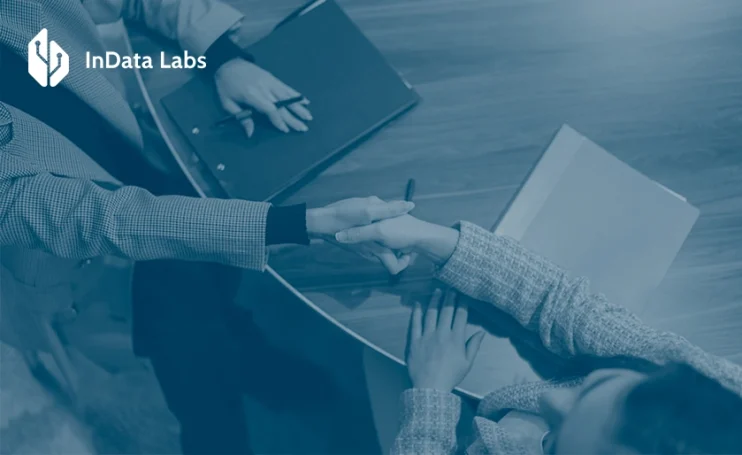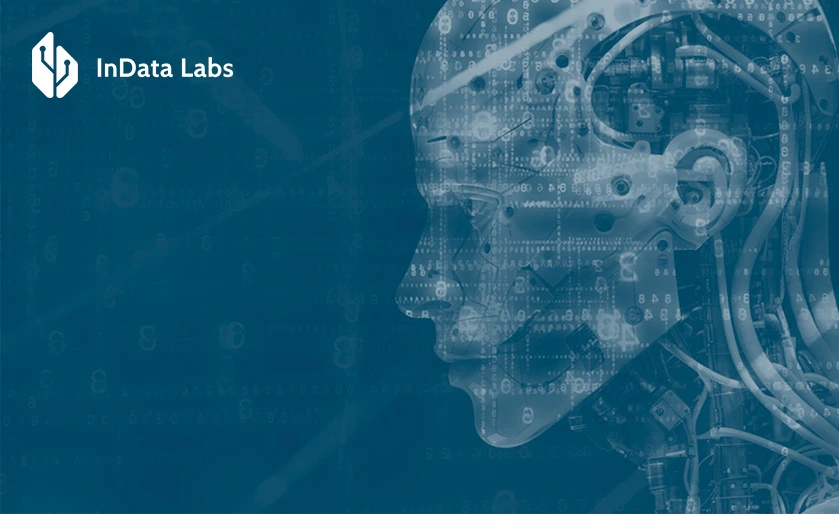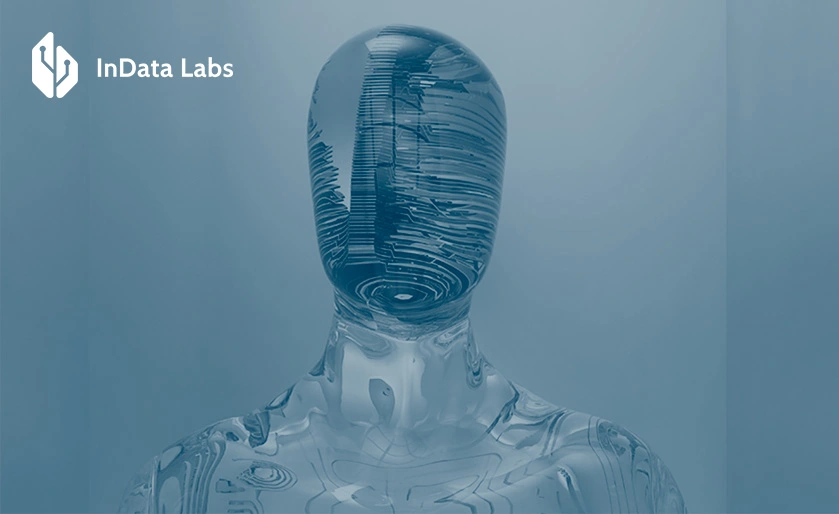Human Resources (HR) is at the heart of any successful business. It is critical in driving organizational performance and fostering a positive workplace culture. AI for HR emerges as a supportive force capable of enhancing core functions, such as recruitment, employee engagement, and performance management.
With the rise of artificial intelligence business applications, HR departments can leverage data-driven insights and automation to streamline their processes and enhance decision-making. This article explores the major AI use cases for HR, highlighting how these technologies transform how companies manage talent and improve operational efficiency.
Unlocking employee insights with AI-powered sentiment analysis
The main asset of any business is its people. Employees are at the heart of every organization, driving its success and growth. Companies, regardless of their size, want to understand how their employees feel. To gain these insights, HR departments can turn to AI consulting and sentiment analysis. The last one includes two important stages – information collection and text analysis. AI definitely shines in the second stage but can also help in the first one.
Necessary information for sentiment analysis is gained from surveys and feedback forms, where employees can express their opinions and concerns. Other sources are emails, chat logs like Slack and Microsoft Teams, and internal networks.
Exit interviews are also a valuable source of honest feedback. Departing employees may feel more comfortable expressing their true feelings about their experiences. AI can be used to create dynamic surveys that change questions in real time based on previous responses. This helps gather more precise sentiment data, as smart algorithms can probe deeper into employees’ opinions. AI-powered chatbots can also maintain effective communication with employees collecting valuable information.
The more textual data collected, the more accurate and insightful the analysis becomes. However, analyzing large volumes of data manually can be a daunting task. That’s why modern sentiment analysis leverages the power of natural language processing (NLP) and machine learning (ML). These advanced technologies enable the rapid and precise identification of positive, negative, and neutral sentiment patterns. And, moreover, uncover hidden insights that might not be evident through conventional feedback mechanisms. Using this knowledge, HR can draw conclusions about the company’s internal health and the state of its employees across various departments.

Source: Unsplash
Let’s delve deeper into the technical aspects. AI models for sentiment analysis are trained on labeled datasets where each text example’s sentiment is predefined. These models classify text based on its sentiment and can even make predictions. Common examples include Support Vector Machines (SVMs), Naive Bayes classifiers, and Decision Trees. More advanced models like Recurrent Neural Networks (RNNs) and Long Short-Term Memory (LSTM) networks can capture context across text sequences, which is essential for understanding sentiment in longer, more complex sentences.
The most sophisticated models, like BERT (Bidirectional Encoder Representations from Transformers) and GPT (Generative Pre-trained Transformer), can understand the context and subtleties of language. This significantly enhances sentiment analysis capabilities, allowing the detection of sarcastic statements and mixed emotions within a single text.
Companies can turn to sentiment analysis services to fully leverage these advanced AI capabilities. These services offer turnkey tools or develop custom solutions tailored to the unique challenges of managing employee sentiment and engagement. This allows companies to respond more effectively to feedback, enhance employee well-being, build stronger relationships with employees, and retain them. Overall, it means more informed decision-making and better strategic planning.
Knowledge-based chatbots for internal HR processes
Knowledge-based chatbots are great assistants for HR professionals. They not only save time but also enhance employee experience while coping with large volumes of requests. Employees can use these chatbots to quickly find answers to common HR questions such as vacation policies, benefits, payroll, performance review procedures, training programs, and much more.
In addition, bots are available 24/7, providing access to HR information whenever employees need it, regardless of time zones and office hours. This is particularly useful for global companies or those with remote or hybrid workforces. When automating routine inquiries and processes, HRs can focus on more strategic tasks, such as employee development and organizational planning.

They can manage more sophisticated conversations that go beyond simple question-and-answer formats, guiding employees through HR processes. Queries can be phrased in different ways. For example, “How many vacation days do I have left?” or “What’s my remaining PTO?”. Both are recognized and lead to the same response.
ML algorithms enable chatbots to learn from every interaction, refining their responses based on past conversations. Employees also receive more personalized support, since bots study their profiles and previous queries. A natural and conversational manner makes interactions more engaging and less robotic. It’s crucial for creating a positive experience. And employees do not feel annoyed by the need to communicate with a chatbot. They know that they can always get fast and high-quality help.
Other AI use cases for the HR department
The impact of generative AI trends on HR is evident. McKinsey’s analysis reveals the largest value potential of about 20% for GenAI in HR in talent acquisition, recruiting, and onboarding. For instance, Coca-Cola and Unilever have integrated technology into the hiring process for screening resumes and conducting initial assessments. Accenture uses AI to automate repetitive HR tasks such as generating employment contracts and managing employee records. This list can be continued indefinitely. Companies increasingly leverage GenAI to optimize various HR functions, making them more efficient and data-driven.
Recruitment and talent acquisition
AI transforms the hiring process, making it more efficient than traditional methods. With the ability to analyze vast amounts of data, technology streamlines the search by matching job requirements with potential candidates’ skills and experiences. It can also automate repetitive tasks, such as resume screening and initial outreach. While recruiters may spend this time building meaningful relationships with candidates. In addition, advanced algorithms allow them to analyze the market, identify trends and patterns, and make predictions in terms of human resources.
Today, diversity and inclusion are important components of a successful recruitment strategy. And AI allows reducing unconscious bias in the hiring process. It ensures that all candidates are evaluated based on their skills and qualifications rather than subjective factors. And all candidates get equal consideration and opportunities. By continuously monitoring and analyzing recruitment practices, AI can provide insights into where improvements can be made, helping companies to attract and retain a diverse talent pool.

Source: Unsplash
AI and HR analytics
AI-driven analytics enables HR teams to process and analyze vast amounts of employee data quickly and accurately, uncovering deep insights into employee behavior, performance, and engagement. Analytics tools utilize advanced ML algorithms to identify patterns and trends. It can uncover performance trends, engagement and productivity levels, employee satisfaction, diversity and inclusion metrics, skill gaps and training needs, employee turnover predictions, and much more. This comprehensive analysis allows HR professionals to make proactive and data-driven decisions that align with organizational goals and optimize workforce management.
AI algorithms predict potential issues before they become significant problems. This is a good basis for prevention. For example, the system can identify employees at risk of burnout or turnover. And in response managers can take some actions for support and retention. Besides that technology can help tailor training programs to address specific skill gaps, ensuring that employees have the necessary tools and knowledge to succeed in their roles.
HR professionals may harness the power of marketing analytics to enhance their understanding of employee needs and preferences. It provides many opportunities, including improving marketing efforts for recruitment, ensuring the effectiveness of internal communications, and, most importantly, creating a strong HR brand.
For instance, AI tools can analyze engagement data, click-through rates on job postings, and responses to internal surveys. This data-driven approach enables HR to design more effective recruitment campaigns, improve onboarding experiences, and create communication strategies that better engage the workforce.
HR content creation
HR professionals have to create a vast amount of content, and also keep it relevant. These are job descriptions, internal communications, training materials, handbooks, policy documents, and more. GenAI can generate high-quality content tailored to specific needs, audiences, and formats, significantly reducing the time and effort required for content creation.
Moreover, GenAI supports HR in creating content that reflects the organization’s commitment to diversity and inclusion. By analyzing language and tone, GenAI can help ensure that all HR materials are free from bias and inclusive of all employees. It can also assist in localizing content for global teams, ensuring that messaging is culturally relevant and accessible across different regions. Technology enables HR teams to communicate more effectively with every employee.

Source: Unsplash
Final words
HR technologies remain one of the top priorities for companies’ management boards, as they recognize the critical role of HR in driving organizational success. Regardless of the size or business domain, AI software for HR is becoming increasingly indispensable as companies seek to enhance their processes and stay competitive in a rapidly changing market.
There is a wide range of turnkey solutions available with various functionalities, such as talent acquisition, performance management, employee engagement, payroll, and predictive analytics. For tailored solutions, companies can collaborate with dedicated development teams to create HR tools that align closely with their strategic goals and organizational culture. This flexibility allows businesses to innovate continuously and adapt their HR strategies, ultimately driving long-term growth and sustainability.
FAQ
-
AI can be used in HR to streamline and enhance various processes, including recruitment, employee engagement, talent management, and workforce planning. It can automate repetitive tasks like resume screening and interview scheduling, improving efficiency and reducing errors.
AI can also analyze employee data to identify trends in performance, predict turnover, and assess employee satisfaction. By leveraging AI, HR teams can gain valuable insights that help make data-driven decisions, foster a more inclusive work environment, and optimize talent acquisition and retention strategies.
-
Generative AI in HR can be used to create personalized employee communications, draft job descriptions, and generate training materials that are tailored to specific roles or learning styles. It can be used to simulate different HR scenarios, such as predicting the outcomes of various hiring strategies or modeling the impact of policy changes on employee sentiment. In addition, GenAI supports diversity and inclusion initiatives in recruiting, training, and management.
-
The responsible use of AI in HR involves ensuring that AI tools are transparent, unbiased, and ethically deployed. It also means protecting employee privacy by ensuring that any data collected is secure and used solely for intended HR purposes. HR professionals should be trained in understanding AI technologies to use them effectively and ethically, ensuring that AI augments human judgment rather than replacing it.
-
AI helps HR in decision-making by providing data-driven insights and predictive analytics that can identify patterns and trends within the workforce. For example, AI can predict which employees are at risk of leaving, allowing HR to take proactive steps to improve retention. It can also analyze performance data to identify high-potential employees for development programs or uncover gaps in skills that need to be addressed through training. By automating the analysis of large datasets, AI enables HR professionals to make more informed, strategic decisions that align with organizational goals.
-
The applications of AI in HR include automated resume screening, candidate matching, employee sentiment analysis, predictive analytics for turnover and retention, personalized employee development programs, and chatbots for answering employee queries. AI can also be used for diversity and inclusion efforts by identifying and mitigating biases in recruitment and promotion processes. Additionally, AI can optimize workforce planning by analyzing trends in productivity and forecasting future hiring needs.
-
HR can leverage AI by integrating it into various processes such as recruitment, talent management, employee engagement, and performance evaluation. By using AI-powered tools, HR teams can automate time-consuming tasks like resume screening and scheduling, enabling them to focus on strategic activities.
AI can also provide insights into employee sentiment and engagement levels, helping HR develop targeted initiatives to improve morale and productivity. Furthermore, AI can assist in personalizing training and development programs, ensuring that employees receive relevant support to enhance their skills and advance in their careers.



